Ted
Curtis studio/Upstairs Productions
The information
and pictures on this page are in flux as the project continues. Check
back from time to time for updates. All of the small pix on
the left of your screen can be clicked to see a larger image.
In the
spring of 2002, I was contacted by a long-time friend and client, Ted Curtis,
who detailed his plans for what could be considered the World's Ultimate
Home Studio...here in Oklahoma City. Ted previously owned Studio
7 in OKC, which is now under different ownership:
Studio
7/Lunacy Records
before
venturing into a very sucessful Tex-Mex restaurant business. If you're
in OKC, dine at Ted's Cafe Escondido, located at 2836 NW 68th...just West
of May Ave. on NW 68th Street for some of the best Tex-Mex food on the
planet!
Ted outlined
his project. He had acquired a late-model Amek 9098i console (72
in/48 buss, design by Rupert Neve). You can find more details here:
Amek
9098i information
Ted installed
48 channels of the 192K "Radar" hard disk recorders in addition to his
64 channels of ProTools HD. For tracking basics, he had obtained
a MCI JH-24 2" 16 track analog recorder, as well as a Mike Spitz/ATR Services
Ampex
ATR-100 1" 2-track for mixdowns.
The original
construction of Ted's house had a partial second floor which included a
nicely finished space for what might be used as a game or media room.
His original concept was to use that space for the recording room and finish
out the adjoining attic spaces for the control room and additional recording
spaces.
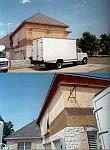 |
After
considering the required space for all the equipment and input from his
acoustical consultant Francis
Manzella, Ted decided to totally replace the structure above the garage
in order to house the control room. In these pix from summer of 2001,
notice the opening in the west side of the new structure; that's the entry
point for recording gear that is too large to travel up the interior stairs,
and will be closed with custom "sound doors". |
 |
These
three pix show the control room area under construction last summer.
You can see the "door" opening to the outdoors in the top two. The
lower pic shows the construction of the CR floor (as viewed from the garage
area below) which is required to hold the weight of the Amek console (estimated
at 5000-6000 pounds). |
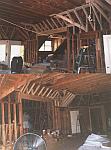 |
Here
are pics made Summer 2002 during construction of the main recording room. |
 |
January
20, 2003 was one of those amazing days in OKC: daytime temps were in the
60's. The piano movers trollied the Yamaha Grand from the house on
a piano dolly in the first pic. Then it is picked up (along with
two workers) and forklifted up to the opening on the second floor.
As she watched, Ted's wife made a comment about possible "expensive firewood"
<g>. |
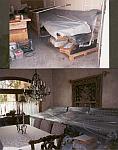 |
Prior
to "D-Day", the Amek buckets had been moved from the family dining room
(shown in the lower pic) to the garage so they could be hoisted up to the
second floor. Since the frames were delivered on pallets, it was
comparatively easy to relocate them with a pallet jack. |
 |
One by
one. all three of the Amek "buckets" were moved from the garage via a pallet
jack onto the forklift, then hoisted up into the opening in the control
room wall. |
 |
Yet another
Amek Bucket takes a ride on the forklift. |
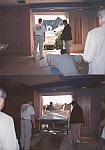 |
For the
third (and last) Amek move, I shot these pix from the inside of the new
control room. It took men working both outside the loading doors as well
as inside the control room to maneuver the heavy Amek console sections
from the forklift and into the control room. |
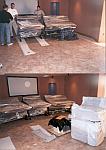 |
To move
each of the buckets to their final (approx) location, we placed carpet
scraps under the legs of the Amek buckets so they could be dragged around
with the help of 4-6 "volunteers". In the top pic, you can see the
magnitude of each bucket, and in the lower, you can spot the MCI 24 track
(wrapped in white plastic) and the Ampex ATR-100 1" 2-track (sitting on
the floor to the left of the MCI). |
 |
The electrical
requirements for the studio are extensive due to the extra zones of HVAC
and the approx. 9600 Watts required to power the Amek. Ted had OG+E
install a new service entrance. In the second pic, the EquiTech
balanced power system is in the large gray wall-mounted box. The
four smaller boxes to the right are Surgex
surge protection units. The bottom pic shows the racks which house
the nine Amek supplies (only three were installed). |
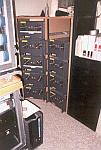 |
Here's
the final Amek 9098i power supply configuration. The desk requires
9 of the rack mounted supplies (each houses multiple International Power
brand open frame linear supplies). |
 |
Here
are some pics shot the same day as the equipment hoisting. The top
two shots are of the main studio room, taken from approximately the same
positions as in the construction pics (above). Notice the wall and
ceiling acoustical diffusors and the nice appointments. The third
picture shows the Yamaha sitting in it's own room (accessed through the
sliding doors seen in the upper pics). |
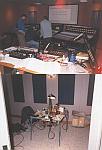 |
In early
Feb., 2003, we began final wiring and installation. In the top pic,
you can see the Amek in place and operational (Dave and Donnie from Amek/Nashville
are standing on each side of Ted, while the projection screen displays
console automation). In the foreground, I have set up "shop" doing
some wiring projects. In the lower pic, you can see my "portable
workbench", since I HATE sitting on the floor to solder. |
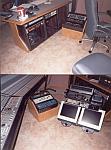 |
After
weeks of work, we were ready for the first session. Here, I show
some of the outboard gear. In the top pic, a Manley EQ sits above
Massenburg EQ and compressors in the "East rolling rack". The desk
rack houses a SSL dual channel compressor, Sony "room simulator" and two
Distressors. The lower pic shows the Radar remote, and an Eventide
"Orville", an United Audio reissue LA-2, and a TubeTech tri-band stereo
compressor in the "West" rolling rack. |
 |
In the
top pic, the drum mics are being set up (unfortunately, I was hopping all
over the place getting the session ready, so I couldn't take too many session
pix). In the middle pic, there's the MCI 2" 16 track (in a pre-wired
24 track frame) sitting next to the Ampex ATR-100 1" 2 track. The
lower pic shows the machine room, with 48 tracks of Radar in the rear rack
and ProTools HD in the portable rack. We tracked to the MCI 16 *and*
Radar (at 48K) for the basics, but elected to use the MCI tracks (and flew
them into Radar for overdubs). |
Ted is
getting some press for this impressive room:
Transaudio
Direct Article
The March,
2004 issue of Mix Magazine also features Ted's studio as the cover item.
Contact
info:
Email:
BrianARoth@cox.net
Cell/voicemail/pager:
405-630-7509
[Back
to Brian Roth Technical Services home]
|














